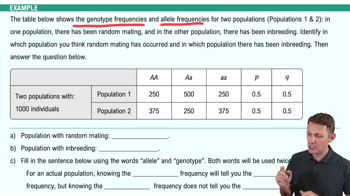Table of contents
- 1. Introduction to Biology
- 2. Chemistry
- 3. Water
- 4. Biomolecules
- 5. Cell Components
- 6. The Membrane
- 7. Energy and Metabolism
- 8. Respiration
- 9. Photosynthesis
- 10. Cell Signaling
- 11. Cell Division
- 12. Meiosis
- 13. Mendelian Genetics
- Introduction to Mendel's Experiments
- Genotype vs. Phenotype
- Punnett Squares
- Mendel's Experiments
- Mendel's Laws
- Monohybrid Crosses
- Test Crosses
- Dihybrid Crosses
- Punnett Square Probability
- Incomplete Dominance vs. Codominance
- Epistasis
- Non-Mendelian Genetics
- Pedigrees
- Autosomal Inheritance
- Sex-Linked Inheritance
- X-Inactivation
- 14. DNA Synthesis
- 15. Gene Expression
- 16. Regulation of Expression
- Introduction to Regulation of Gene Expression
- Prokaryotic Gene Regulation via Operons
- The Lac Operon
- Glucose's Impact on Lac Operon
- The Trp Operon
- Review of the Lac Operon & Trp Operon
- Introduction to Eukaryotic Gene Regulation
- Eukaryotic Chromatin Modifications
- Eukaryotic Transcriptional Control
- Eukaryotic Post-Transcriptional Regulation
- Eukaryotic Post-Translational Regulation
- 17. Viruses
- 18. Biotechnology
- 19. Genomics
- 20. Development
- 21. Evolution
- 22. Evolution of Populations
- 23. Speciation
- 24. History of Life on Earth
- 25. Phylogeny
- 26. Prokaryotes
- 27. Protists
- 28. Plants
- 29. Fungi
- 30. Overview of Animals
- 31. Invertebrates
- 32. Vertebrates
- 33. Plant Anatomy
- 34. Vascular Plant Transport
- 35. Soil
- 36. Plant Reproduction
- 37. Plant Sensation and Response
- 38. Animal Form and Function
- 39. Digestive System
- 40. Circulatory System
- 41. Immune System
- 42. Osmoregulation and Excretion
- 43. Endocrine System
- 44. Animal Reproduction
- 45. Nervous System
- 46. Sensory Systems
- 47. Muscle Systems
- 48. Ecology
- 49. Animal Behavior
- 50. Population Ecology
- 51. Community Ecology
- 52. Ecosystems
- 53. Conservation Biology
22. Evolution of Populations
Non-Random Mating
22. Evolution of Populations
Non-Random Mating
Practice this topic
- Multiple Choice
In a 2019 paper in Mammalian Genome, Chu et al. showed that golden retrievers with higher rates of inbreeding had fewer offspring, suggesting inbreeding depression. Which of the following conclusions could you draw about the population?
227views1rank - Multiple ChoiceWhich of the following is not a result of inbreeding?1views
- Multiple ChoiceWhat is assortative mating in the context of non-random mating?1views


